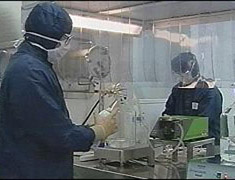| At the moment,
the word "terrorism" conjures up images of 9/11
and the ghastly violence against civilians in Iraq, Pakistan,
Spain, Indonesia and other bloody precincts of al Qaeda's
global jihad. But of course terrorism has an infamous history,
not least in the past half-century, and it has inspired
all sorts of efforts to thwart it, with varying results.
In
"Blind Spot," Timothy Naftali surveys the U.S.
government's response to the threat of international terrorism
from the 1940s to the present day. He begins with a previously
undisclosed plot by the Nazis to assassinate Gen. Eisenhower
and moves through, among other things, the terrorist strategies
of the KGB, the plane hijackings of the 1970s, the activities
of Hezbollah and the PLO, the 1988 bombing of Pan Am Flight
103 over Lockerbie, Scotland, and the terrorism of Osama
bin Laden and 9/11. "Blind Spot" is that rare
phenomenon: a work of original research on a subject of
great importance that is also lucidly written
Mr.
Naftali does not present a pretty picture, though. By pulling
together documents from 10 administrations, he shows how
the American government has failed to confront the threat
of terrorism with anything like the necessary decisiveness
or skill. For a half-century, bureaucratic infighting has
retarded whatever counterterrorism policy there was, and
the policy itself, Mr. Naftali notes, has often been chaotic.
"I
have come to believe less in the efficiency of conspiracies
[e.g., those suggested for 9/11] than I do in the inefficiency
of government," Mr. Naftali writes. According to his
analysis, such inefficiency has taken the form of good intelligence
being ignored or not being properly passed up the chain
of command so that it can be acted upon. One remedy to such
incompetence is reorganization or, as Mr Naftali writes,
creating a "centralizing force in intelligence"
that cuts through the existing "bureaucratic layer."
The
problem may go deeper, however -- beyond the relaying of
intelligence to the actual gathering of it. Until 9/11,
the FBI was the agency with the principal responsibility
for counterespionage. Even if the CIA found a spy in its
own ranks (for example, Aldrich Ames), the FBI had to be
called in to investigate and arrest him. But the FBI's own
history, over several decades, is illuminating in this respect.
Its attempts to penetrate potential terrorist groups --
including the Ku Klux Klan, the Black Panthers and various
militias -- ran into serious problems, and little wonder:
Positioning an agent in a terrorist cell is horrendously
difficult, and "managing" him is a delicate matter,
especially when the cell is involved in murderous activities.
True,
there are many methods for gathering intelligence aside
from using agents. But the information itself, however it
is arrived at, must be interpreted and placed within the
proper mosaic -- the famous problem of separating signals
from noise. How reliable would a "centralizing force"
be at such a task? The recent Robb-Silberman Commission
had access to every stage of intelligence-gathering and
analysis on the subject of Iraq's weapons of mass destruction.
It concluded that all the relevant U.S. agencies, from the
Clinton years through President Bush's first term, consistently
misinterpreted both human and technical intelligence. Unless
such habits of error are corrected, reorganization would
result in merely a more efficient arrangement of the deck
chairs on the Titanic.
But
intelligence-gathering is not the only means of fighting
terrorism, either. One alternative is security, which operates
on the idea that a target can be protected even if there
is no specific warning of a threat. Consider El Al airlines.
Instead of waiting for intelligence alerts, it relies on
locked cockpits, air marshals and rigorous screening procedures.
Such security has come at a cost -- $10 to $20 per passenger
per flight -- but no El Al plane has been commandeered in
1968.
In
the U.S., as Mr. Naftali demonstrates, petty political considerations
-- the fear, for instance, of "fight[ing] with the
airlines and their main federal ally, the FAA" -- have
led the government to a policy quite different from that
of the Israelis. Mr. Naftali even notes (although without
providing a source or date) that cockpit doors, for an unspecified
period, "were routinely left open during takeoffs and
landings, the two most dangerous periods in flight."
He claims, indeed, that the 9/11 terrorists had learned
that "commercial pilots liked to keep cockpit doors
open in the first ten minutes of flight."
FAA regulations required locked cockpit doors. Did the pilots
on American Airlines and United Airlines flights routinely
leave theirs open, as Mr. Naftali suggests? If so, the airlines
have much to answer for.
[back
to archive]
|



